Systems Thinking: Addressing Household Food Waste for Sustainability
VerifiedAdded on 2023/06/13
|8
|2311
|354
Essay
AI Summary
This essay argues that systems thinking is crucial for developing solutions to sustainability challenges, particularly the problem of household food waste. It highlights the differences between traditional and systems thinking approaches, emphasizing the latter's focus on inter-relationships within a system. The essay uses the example of household food waste in Australia, a significant environmental and economic issue, to illustrate the application of systems thinking. It discusses the importance of a holistic approach, resource valuation, mindset changes, and redesigning the food system to minimize waste. The essay concludes that adopting systems thinking can lead to sustainable food management, waste reduction, and resource conservation, as demonstrated by initiatives in Australia.
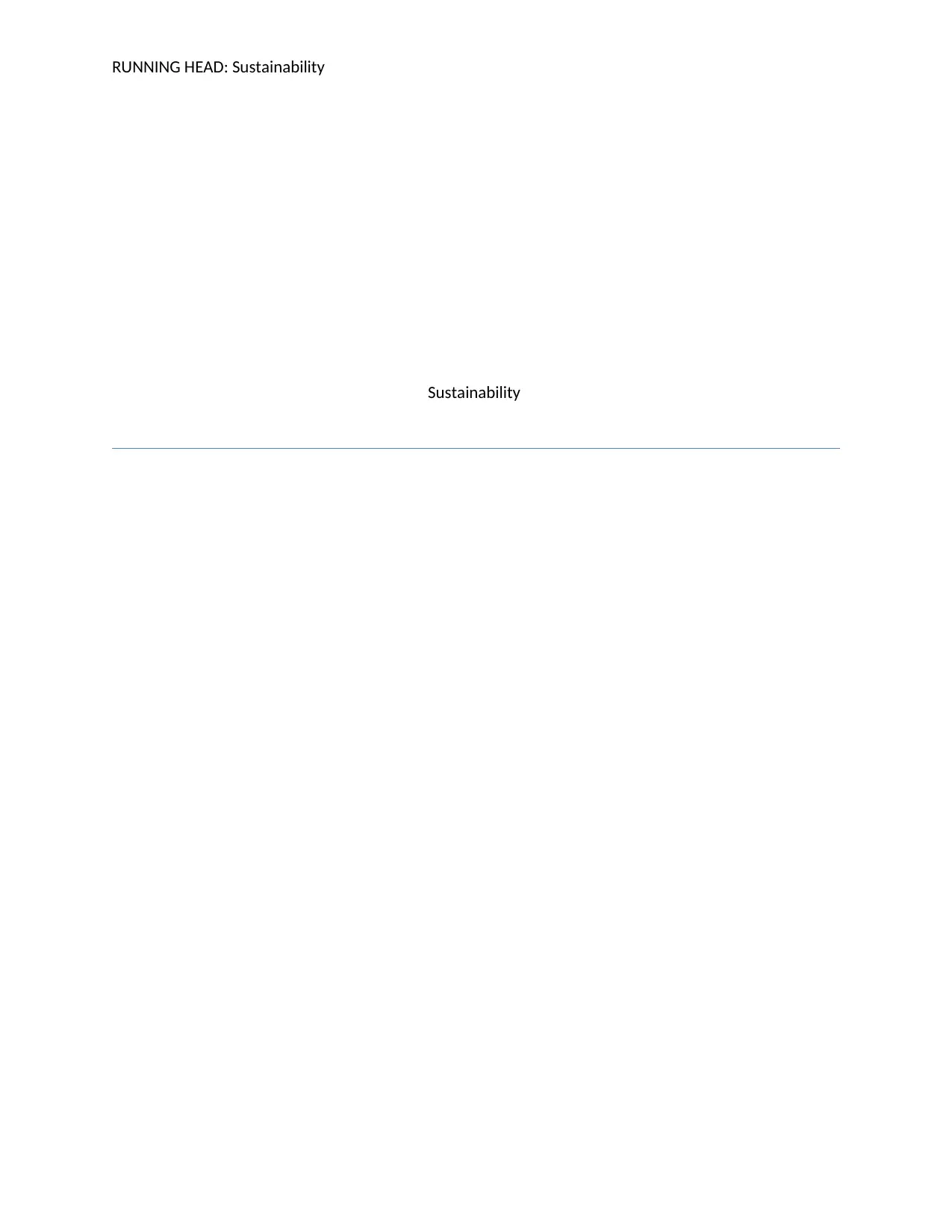
RUNNING HEAD: Sustainability
Sustainability
Sustainability
Paraphrase This Document
Need a fresh take? Get an instant paraphrase of this document with our AI Paraphraser
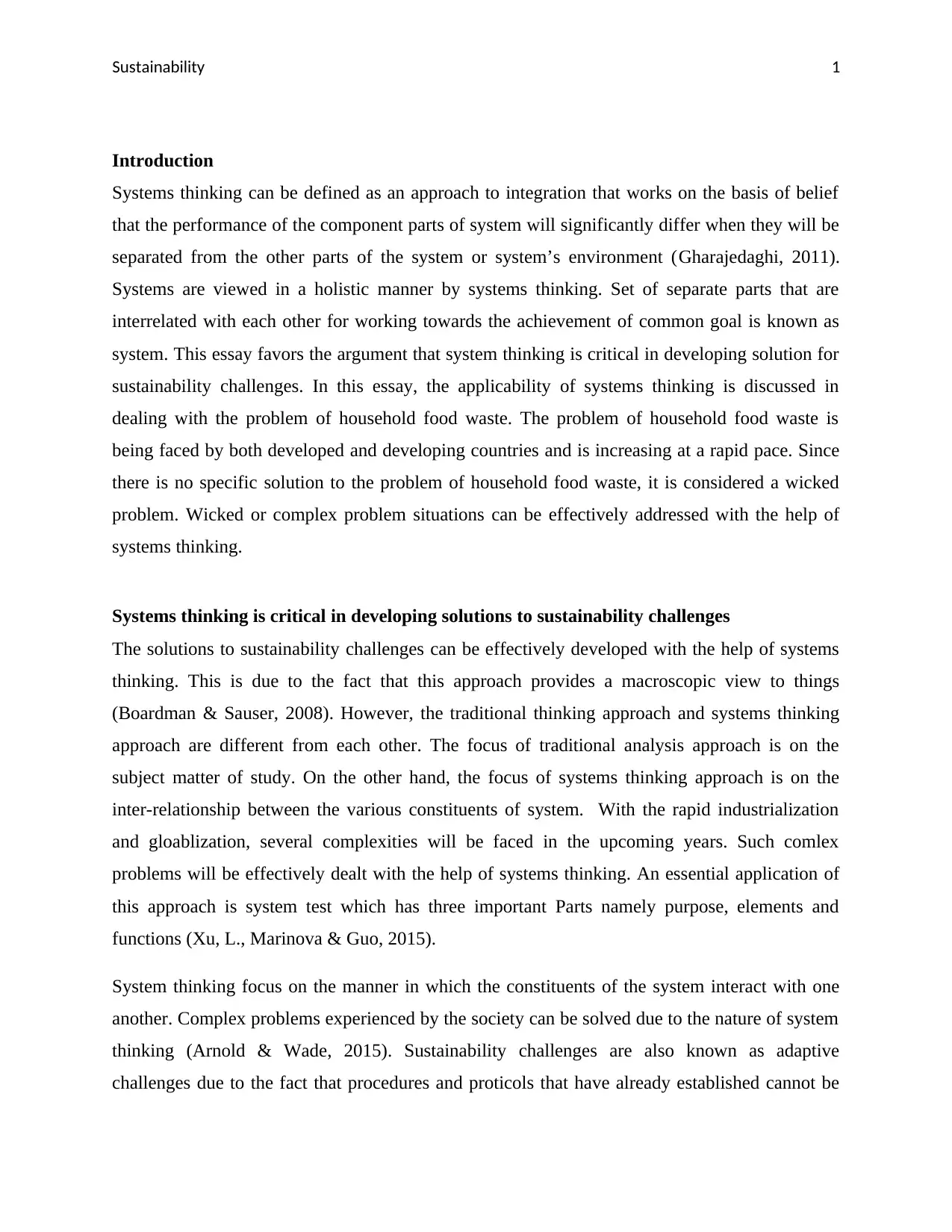
Sustainability 1
Introduction
Systems thinking can be defined as an approach to integration that works on the basis of belief
that the performance of the component parts of system will significantly differ when they will be
separated from the other parts of the system or system’s environment (Gharajedaghi, 2011).
Systems are viewed in a holistic manner by systems thinking. Set of separate parts that are
interrelated with each other for working towards the achievement of common goal is known as
system. This essay favors the argument that system thinking is critical in developing solution for
sustainability challenges. In this essay, the applicability of systems thinking is discussed in
dealing with the problem of household food waste. The problem of household food waste is
being faced by both developed and developing countries and is increasing at a rapid pace. Since
there is no specific solution to the problem of household food waste, it is considered a wicked
problem. Wicked or complex problem situations can be effectively addressed with the help of
systems thinking.
Systems thinking is critical in developing solutions to sustainability challenges
The solutions to sustainability challenges can be effectively developed with the help of systems
thinking. This is due to the fact that this approach provides a macroscopic view to things
(Boardman & Sauser, 2008). However, the traditional thinking approach and systems thinking
approach are different from each other. The focus of traditional analysis approach is on the
subject matter of study. On the other hand, the focus of systems thinking approach is on the
inter-relationship between the various constituents of system. With the rapid industrialization
and gloablization, several complexities will be faced in the upcoming years. Such comlex
problems will be effectively dealt with the help of systems thinking. An essential application of
this approach is system test which has three important Parts namely purpose, elements and
functions (Xu, L., Marinova & Guo, 2015).
System thinking focus on the manner in which the constituents of the system interact with one
another. Complex problems experienced by the society can be solved due to the nature of system
thinking (Arnold & Wade, 2015). Sustainability challenges are also known as adaptive
challenges due to the fact that procedures and proticols that have already established cannot be
Introduction
Systems thinking can be defined as an approach to integration that works on the basis of belief
that the performance of the component parts of system will significantly differ when they will be
separated from the other parts of the system or system’s environment (Gharajedaghi, 2011).
Systems are viewed in a holistic manner by systems thinking. Set of separate parts that are
interrelated with each other for working towards the achievement of common goal is known as
system. This essay favors the argument that system thinking is critical in developing solution for
sustainability challenges. In this essay, the applicability of systems thinking is discussed in
dealing with the problem of household food waste. The problem of household food waste is
being faced by both developed and developing countries and is increasing at a rapid pace. Since
there is no specific solution to the problem of household food waste, it is considered a wicked
problem. Wicked or complex problem situations can be effectively addressed with the help of
systems thinking.
Systems thinking is critical in developing solutions to sustainability challenges
The solutions to sustainability challenges can be effectively developed with the help of systems
thinking. This is due to the fact that this approach provides a macroscopic view to things
(Boardman & Sauser, 2008). However, the traditional thinking approach and systems thinking
approach are different from each other. The focus of traditional analysis approach is on the
subject matter of study. On the other hand, the focus of systems thinking approach is on the
inter-relationship between the various constituents of system. With the rapid industrialization
and gloablization, several complexities will be faced in the upcoming years. Such comlex
problems will be effectively dealt with the help of systems thinking. An essential application of
this approach is system test which has three important Parts namely purpose, elements and
functions (Xu, L., Marinova & Guo, 2015).
System thinking focus on the manner in which the constituents of the system interact with one
another. Complex problems experienced by the society can be solved due to the nature of system
thinking (Arnold & Wade, 2015). Sustainability challenges are also known as adaptive
challenges due to the fact that procedures and proticols that have already established cannot be
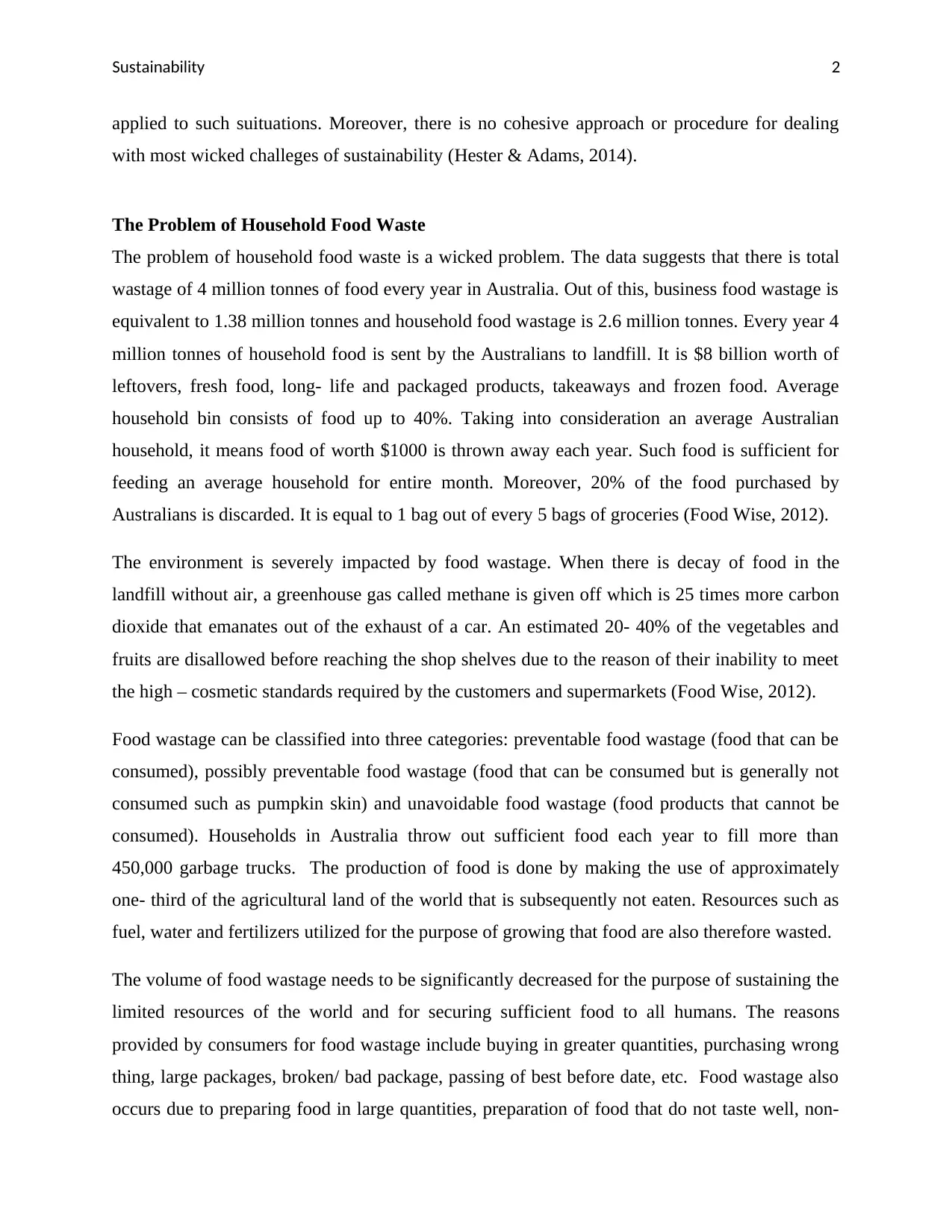
Sustainability 2
applied to such suituations. Moreover, there is no cohesive approach or procedure for dealing
with most wicked challeges of sustainability (Hester & Adams, 2014).
The Problem of Household Food Waste
The problem of household food waste is a wicked problem. The data suggests that there is total
wastage of 4 million tonnes of food every year in Australia. Out of this, business food wastage is
equivalent to 1.38 million tonnes and household food wastage is 2.6 million tonnes. Every year 4
million tonnes of household food is sent by the Australians to landfill. It is $8 billion worth of
leftovers, fresh food, long- life and packaged products, takeaways and frozen food. Average
household bin consists of food up to 40%. Taking into consideration an average Australian
household, it means food of worth $1000 is thrown away each year. Such food is sufficient for
feeding an average household for entire month. Moreover, 20% of the food purchased by
Australians is discarded. It is equal to 1 bag out of every 5 bags of groceries (Food Wise, 2012).
The environment is severely impacted by food wastage. When there is decay of food in the
landfill without air, a greenhouse gas called methane is given off which is 25 times more carbon
dioxide that emanates out of the exhaust of a car. An estimated 20- 40% of the vegetables and
fruits are disallowed before reaching the shop shelves due to the reason of their inability to meet
the high – cosmetic standards required by the customers and supermarkets (Food Wise, 2012).
Food wastage can be classified into three categories: preventable food wastage (food that can be
consumed), possibly preventable food wastage (food that can be consumed but is generally not
consumed such as pumpkin skin) and unavoidable food wastage (food products that cannot be
consumed). Households in Australia throw out sufficient food each year to fill more than
450,000 garbage trucks. The production of food is done by making the use of approximately
one- third of the agricultural land of the world that is subsequently not eaten. Resources such as
fuel, water and fertilizers utilized for the purpose of growing that food are also therefore wasted.
The volume of food wastage needs to be significantly decreased for the purpose of sustaining the
limited resources of the world and for securing sufficient food to all humans. The reasons
provided by consumers for food wastage include buying in greater quantities, purchasing wrong
thing, large packages, broken/ bad package, passing of best before date, etc. Food wastage also
occurs due to preparing food in large quantities, preparation of food that do not taste well, non-
applied to such suituations. Moreover, there is no cohesive approach or procedure for dealing
with most wicked challeges of sustainability (Hester & Adams, 2014).
The Problem of Household Food Waste
The problem of household food waste is a wicked problem. The data suggests that there is total
wastage of 4 million tonnes of food every year in Australia. Out of this, business food wastage is
equivalent to 1.38 million tonnes and household food wastage is 2.6 million tonnes. Every year 4
million tonnes of household food is sent by the Australians to landfill. It is $8 billion worth of
leftovers, fresh food, long- life and packaged products, takeaways and frozen food. Average
household bin consists of food up to 40%. Taking into consideration an average Australian
household, it means food of worth $1000 is thrown away each year. Such food is sufficient for
feeding an average household for entire month. Moreover, 20% of the food purchased by
Australians is discarded. It is equal to 1 bag out of every 5 bags of groceries (Food Wise, 2012).
The environment is severely impacted by food wastage. When there is decay of food in the
landfill without air, a greenhouse gas called methane is given off which is 25 times more carbon
dioxide that emanates out of the exhaust of a car. An estimated 20- 40% of the vegetables and
fruits are disallowed before reaching the shop shelves due to the reason of their inability to meet
the high – cosmetic standards required by the customers and supermarkets (Food Wise, 2012).
Food wastage can be classified into three categories: preventable food wastage (food that can be
consumed), possibly preventable food wastage (food that can be consumed but is generally not
consumed such as pumpkin skin) and unavoidable food wastage (food products that cannot be
consumed). Households in Australia throw out sufficient food each year to fill more than
450,000 garbage trucks. The production of food is done by making the use of approximately
one- third of the agricultural land of the world that is subsequently not eaten. Resources such as
fuel, water and fertilizers utilized for the purpose of growing that food are also therefore wasted.
The volume of food wastage needs to be significantly decreased for the purpose of sustaining the
limited resources of the world and for securing sufficient food to all humans. The reasons
provided by consumers for food wastage include buying in greater quantities, purchasing wrong
thing, large packages, broken/ bad package, passing of best before date, etc. Food wastage also
occurs due to preparing food in large quantities, preparation of food that do not taste well, non-
⊘ This is a preview!⊘
Do you want full access?
Subscribe today to unlock all pages.

Trusted by 1+ million students worldwide
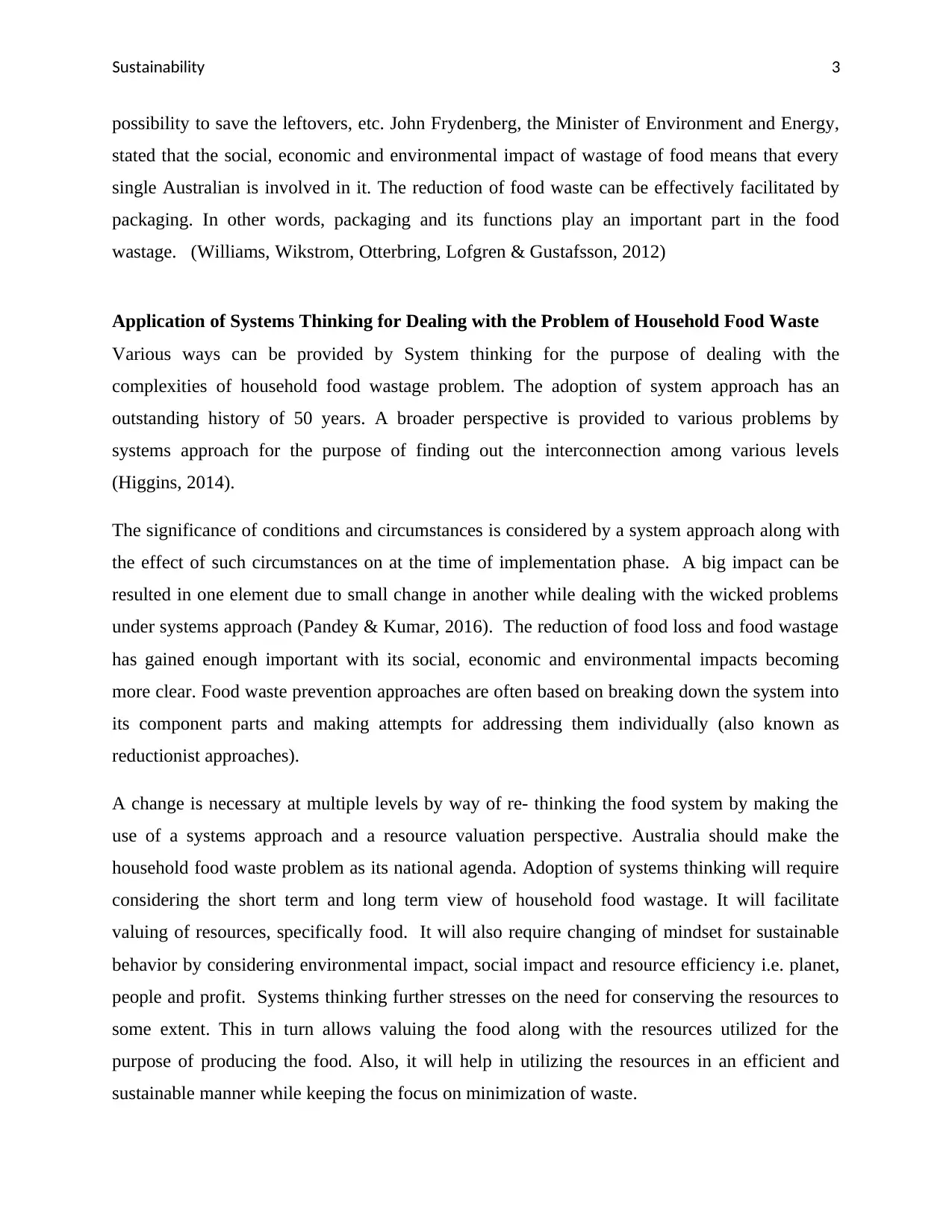
Sustainability 3
possibility to save the leftovers, etc. John Frydenberg, the Minister of Environment and Energy,
stated that the social, economic and environmental impact of wastage of food means that every
single Australian is involved in it. The reduction of food waste can be effectively facilitated by
packaging. In other words, packaging and its functions play an important part in the food
wastage. (Williams, Wikstrom, Otterbring, Lofgren & Gustafsson, 2012)
Application of Systems Thinking for Dealing with the Problem of Household Food Waste
Various ways can be provided by System thinking for the purpose of dealing with the
complexities of household food wastage problem. The adoption of system approach has an
outstanding history of 50 years. A broader perspective is provided to various problems by
systems approach for the purpose of finding out the interconnection among various levels
(Higgins, 2014).
The significance of conditions and circumstances is considered by a system approach along with
the effect of such circumstances on at the time of implementation phase. A big impact can be
resulted in one element due to small change in another while dealing with the wicked problems
under systems approach (Pandey & Kumar, 2016). The reduction of food loss and food wastage
has gained enough important with its social, economic and environmental impacts becoming
more clear. Food waste prevention approaches are often based on breaking down the system into
its component parts and making attempts for addressing them individually (also known as
reductionist approaches).
A change is necessary at multiple levels by way of re- thinking the food system by making the
use of a systems approach and a resource valuation perspective. Australia should make the
household food waste problem as its national agenda. Adoption of systems thinking will require
considering the short term and long term view of household food wastage. It will facilitate
valuing of resources, specifically food. It will also require changing of mindset for sustainable
behavior by considering environmental impact, social impact and resource efficiency i.e. planet,
people and profit. Systems thinking further stresses on the need for conserving the resources to
some extent. This in turn allows valuing the food along with the resources utilized for the
purpose of producing the food. Also, it will help in utilizing the resources in an efficient and
sustainable manner while keeping the focus on minimization of waste.
possibility to save the leftovers, etc. John Frydenberg, the Minister of Environment and Energy,
stated that the social, economic and environmental impact of wastage of food means that every
single Australian is involved in it. The reduction of food waste can be effectively facilitated by
packaging. In other words, packaging and its functions play an important part in the food
wastage. (Williams, Wikstrom, Otterbring, Lofgren & Gustafsson, 2012)
Application of Systems Thinking for Dealing with the Problem of Household Food Waste
Various ways can be provided by System thinking for the purpose of dealing with the
complexities of household food wastage problem. The adoption of system approach has an
outstanding history of 50 years. A broader perspective is provided to various problems by
systems approach for the purpose of finding out the interconnection among various levels
(Higgins, 2014).
The significance of conditions and circumstances is considered by a system approach along with
the effect of such circumstances on at the time of implementation phase. A big impact can be
resulted in one element due to small change in another while dealing with the wicked problems
under systems approach (Pandey & Kumar, 2016). The reduction of food loss and food wastage
has gained enough important with its social, economic and environmental impacts becoming
more clear. Food waste prevention approaches are often based on breaking down the system into
its component parts and making attempts for addressing them individually (also known as
reductionist approaches).
A change is necessary at multiple levels by way of re- thinking the food system by making the
use of a systems approach and a resource valuation perspective. Australia should make the
household food waste problem as its national agenda. Adoption of systems thinking will require
considering the short term and long term view of household food wastage. It will facilitate
valuing of resources, specifically food. It will also require changing of mindset for sustainable
behavior by considering environmental impact, social impact and resource efficiency i.e. planet,
people and profit. Systems thinking further stresses on the need for conserving the resources to
some extent. This in turn allows valuing the food along with the resources utilized for the
purpose of producing the food. Also, it will help in utilizing the resources in an efficient and
sustainable manner while keeping the focus on minimization of waste.
Paraphrase This Document
Need a fresh take? Get an instant paraphrase of this document with our AI Paraphraser
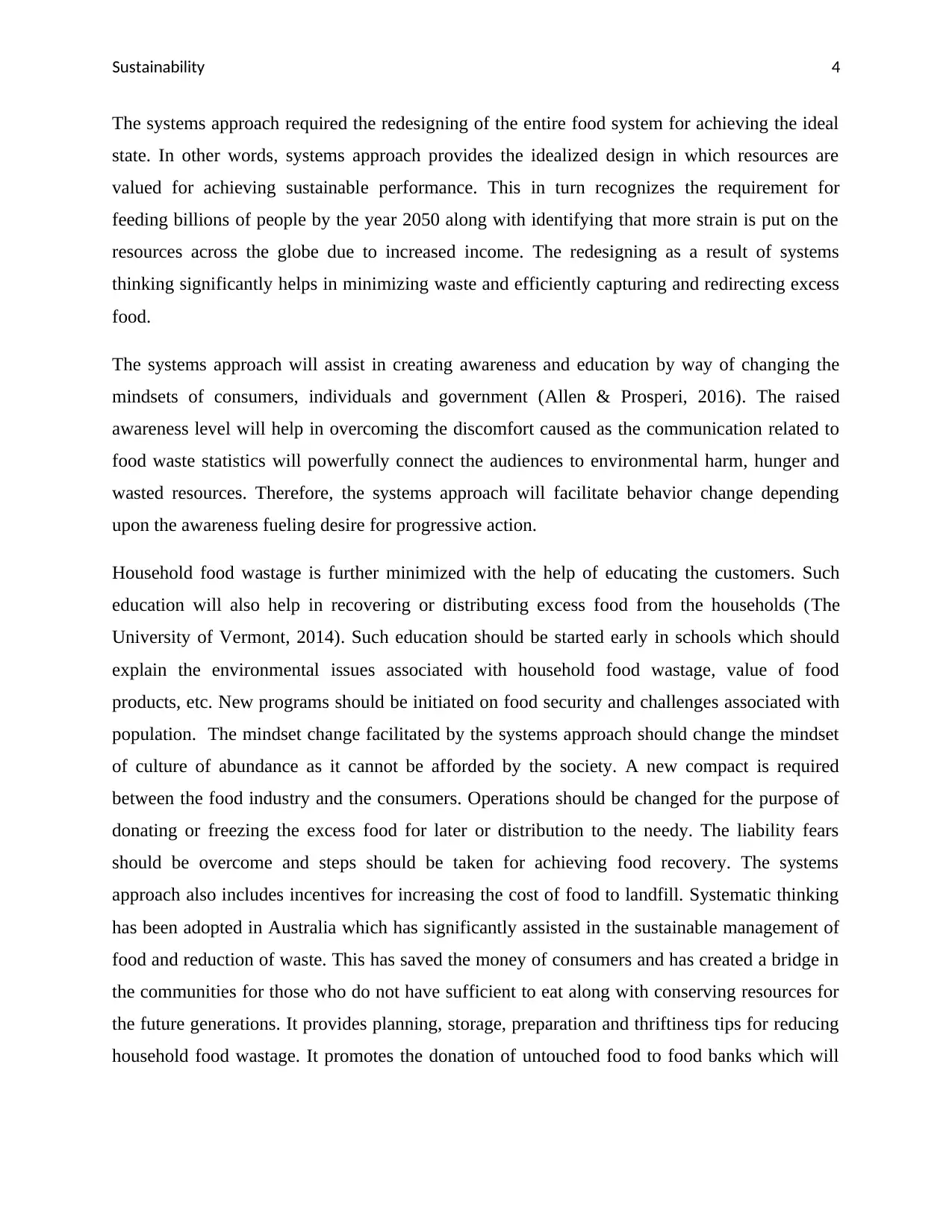
Sustainability 4
The systems approach required the redesigning of the entire food system for achieving the ideal
state. In other words, systems approach provides the idealized design in which resources are
valued for achieving sustainable performance. This in turn recognizes the requirement for
feeding billions of people by the year 2050 along with identifying that more strain is put on the
resources across the globe due to increased income. The redesigning as a result of systems
thinking significantly helps in minimizing waste and efficiently capturing and redirecting excess
food.
The systems approach will assist in creating awareness and education by way of changing the
mindsets of consumers, individuals and government (Allen & Prosperi, 2016). The raised
awareness level will help in overcoming the discomfort caused as the communication related to
food waste statistics will powerfully connect the audiences to environmental harm, hunger and
wasted resources. Therefore, the systems approach will facilitate behavior change depending
upon the awareness fueling desire for progressive action.
Household food wastage is further minimized with the help of educating the customers. Such
education will also help in recovering or distributing excess food from the households (The
University of Vermont, 2014). Such education should be started early in schools which should
explain the environmental issues associated with household food wastage, value of food
products, etc. New programs should be initiated on food security and challenges associated with
population. The mindset change facilitated by the systems approach should change the mindset
of culture of abundance as it cannot be afforded by the society. A new compact is required
between the food industry and the consumers. Operations should be changed for the purpose of
donating or freezing the excess food for later or distribution to the needy. The liability fears
should be overcome and steps should be taken for achieving food recovery. The systems
approach also includes incentives for increasing the cost of food to landfill. Systematic thinking
has been adopted in Australia which has significantly assisted in the sustainable management of
food and reduction of waste. This has saved the money of consumers and has created a bridge in
the communities for those who do not have sufficient to eat along with conserving resources for
the future generations. It provides planning, storage, preparation and thriftiness tips for reducing
household food wastage. It promotes the donation of untouched food to food banks which will
The systems approach required the redesigning of the entire food system for achieving the ideal
state. In other words, systems approach provides the idealized design in which resources are
valued for achieving sustainable performance. This in turn recognizes the requirement for
feeding billions of people by the year 2050 along with identifying that more strain is put on the
resources across the globe due to increased income. The redesigning as a result of systems
thinking significantly helps in minimizing waste and efficiently capturing and redirecting excess
food.
The systems approach will assist in creating awareness and education by way of changing the
mindsets of consumers, individuals and government (Allen & Prosperi, 2016). The raised
awareness level will help in overcoming the discomfort caused as the communication related to
food waste statistics will powerfully connect the audiences to environmental harm, hunger and
wasted resources. Therefore, the systems approach will facilitate behavior change depending
upon the awareness fueling desire for progressive action.
Household food wastage is further minimized with the help of educating the customers. Such
education will also help in recovering or distributing excess food from the households (The
University of Vermont, 2014). Such education should be started early in schools which should
explain the environmental issues associated with household food wastage, value of food
products, etc. New programs should be initiated on food security and challenges associated with
population. The mindset change facilitated by the systems approach should change the mindset
of culture of abundance as it cannot be afforded by the society. A new compact is required
between the food industry and the consumers. Operations should be changed for the purpose of
donating or freezing the excess food for later or distribution to the needy. The liability fears
should be overcome and steps should be taken for achieving food recovery. The systems
approach also includes incentives for increasing the cost of food to landfill. Systematic thinking
has been adopted in Australia which has significantly assisted in the sustainable management of
food and reduction of waste. This has saved the money of consumers and has created a bridge in
the communities for those who do not have sufficient to eat along with conserving resources for
the future generations. It provides planning, storage, preparation and thriftiness tips for reducing
household food wastage. It promotes the donation of untouched food to food banks which will
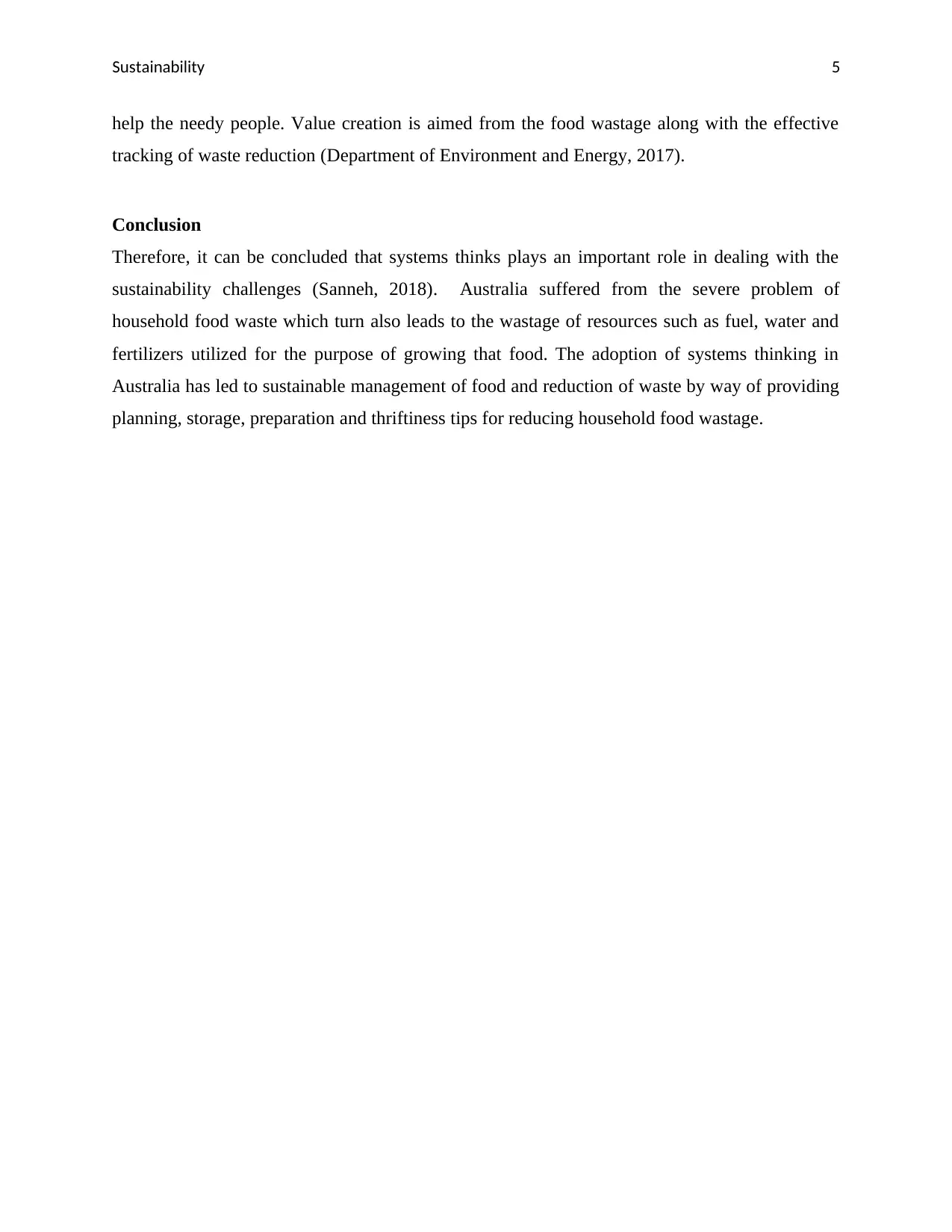
Sustainability 5
help the needy people. Value creation is aimed from the food wastage along with the effective
tracking of waste reduction (Department of Environment and Energy, 2017).
Conclusion
Therefore, it can be concluded that systems thinks plays an important role in dealing with the
sustainability challenges (Sanneh, 2018). Australia suffered from the severe problem of
household food waste which turn also leads to the wastage of resources such as fuel, water and
fertilizers utilized for the purpose of growing that food. The adoption of systems thinking in
Australia has led to sustainable management of food and reduction of waste by way of providing
planning, storage, preparation and thriftiness tips for reducing household food wastage.
help the needy people. Value creation is aimed from the food wastage along with the effective
tracking of waste reduction (Department of Environment and Energy, 2017).
Conclusion
Therefore, it can be concluded that systems thinks plays an important role in dealing with the
sustainability challenges (Sanneh, 2018). Australia suffered from the severe problem of
household food waste which turn also leads to the wastage of resources such as fuel, water and
fertilizers utilized for the purpose of growing that food. The adoption of systems thinking in
Australia has led to sustainable management of food and reduction of waste by way of providing
planning, storage, preparation and thriftiness tips for reducing household food wastage.
⊘ This is a preview!⊘
Do you want full access?
Subscribe today to unlock all pages.

Trusted by 1+ million students worldwide
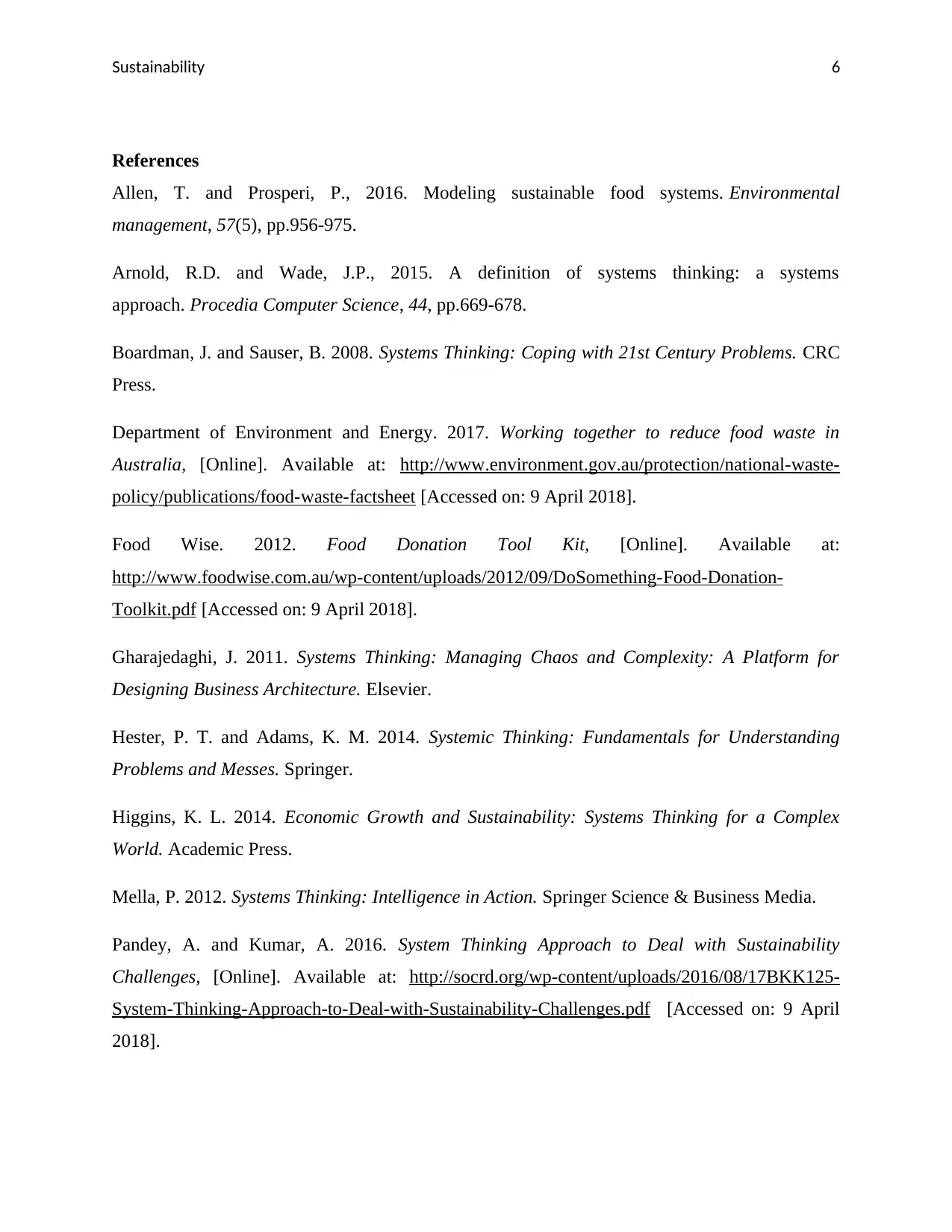
Sustainability 6
References
Allen, T. and Prosperi, P., 2016. Modeling sustainable food systems. Environmental
management, 57(5), pp.956-975.
Arnold, R.D. and Wade, J.P., 2015. A definition of systems thinking: a systems
approach. Procedia Computer Science, 44, pp.669-678.
Boardman, J. and Sauser, B. 2008. Systems Thinking: Coping with 21st Century Problems. CRC
Press.
Department of Environment and Energy. 2017. Working together to reduce food waste in
Australia, [Online]. Available at: http://www.environment.gov.au/protection/national-waste-
policy/publications/food-waste-factsheet [Accessed on: 9 April 2018].
Food Wise. 2012. Food Donation Tool Kit, [Online]. Available at:
http://www.foodwise.com.au/wp-content/uploads/2012/09/DoSomething-Food-Donation-
Toolkit.pdf [Accessed on: 9 April 2018].
Gharajedaghi, J. 2011. Systems Thinking: Managing Chaos and Complexity: A Platform for
Designing Business Architecture. Elsevier.
Hester, P. T. and Adams, K. M. 2014. Systemic Thinking: Fundamentals for Understanding
Problems and Messes. Springer.
Higgins, K. L. 2014. Economic Growth and Sustainability: Systems Thinking for a Complex
World. Academic Press.
Mella, P. 2012. Systems Thinking: Intelligence in Action. Springer Science & Business Media.
Pandey, A. and Kumar, A. 2016. System Thinking Approach to Deal with Sustainability
Challenges, [Online]. Available at: http://socrd.org/wp-content/uploads/2016/08/17BKK125-
System-Thinking-Approach-to-Deal-with-Sustainability-Challenges.pdf [Accessed on: 9 April
2018].
References
Allen, T. and Prosperi, P., 2016. Modeling sustainable food systems. Environmental
management, 57(5), pp.956-975.
Arnold, R.D. and Wade, J.P., 2015. A definition of systems thinking: a systems
approach. Procedia Computer Science, 44, pp.669-678.
Boardman, J. and Sauser, B. 2008. Systems Thinking: Coping with 21st Century Problems. CRC
Press.
Department of Environment and Energy. 2017. Working together to reduce food waste in
Australia, [Online]. Available at: http://www.environment.gov.au/protection/national-waste-
policy/publications/food-waste-factsheet [Accessed on: 9 April 2018].
Food Wise. 2012. Food Donation Tool Kit, [Online]. Available at:
http://www.foodwise.com.au/wp-content/uploads/2012/09/DoSomething-Food-Donation-
Toolkit.pdf [Accessed on: 9 April 2018].
Gharajedaghi, J. 2011. Systems Thinking: Managing Chaos and Complexity: A Platform for
Designing Business Architecture. Elsevier.
Hester, P. T. and Adams, K. M. 2014. Systemic Thinking: Fundamentals for Understanding
Problems and Messes. Springer.
Higgins, K. L. 2014. Economic Growth and Sustainability: Systems Thinking for a Complex
World. Academic Press.
Mella, P. 2012. Systems Thinking: Intelligence in Action. Springer Science & Business Media.
Pandey, A. and Kumar, A. 2016. System Thinking Approach to Deal with Sustainability
Challenges, [Online]. Available at: http://socrd.org/wp-content/uploads/2016/08/17BKK125-
System-Thinking-Approach-to-Deal-with-Sustainability-Challenges.pdf [Accessed on: 9 April
2018].
Paraphrase This Document
Need a fresh take? Get an instant paraphrase of this document with our AI Paraphraser
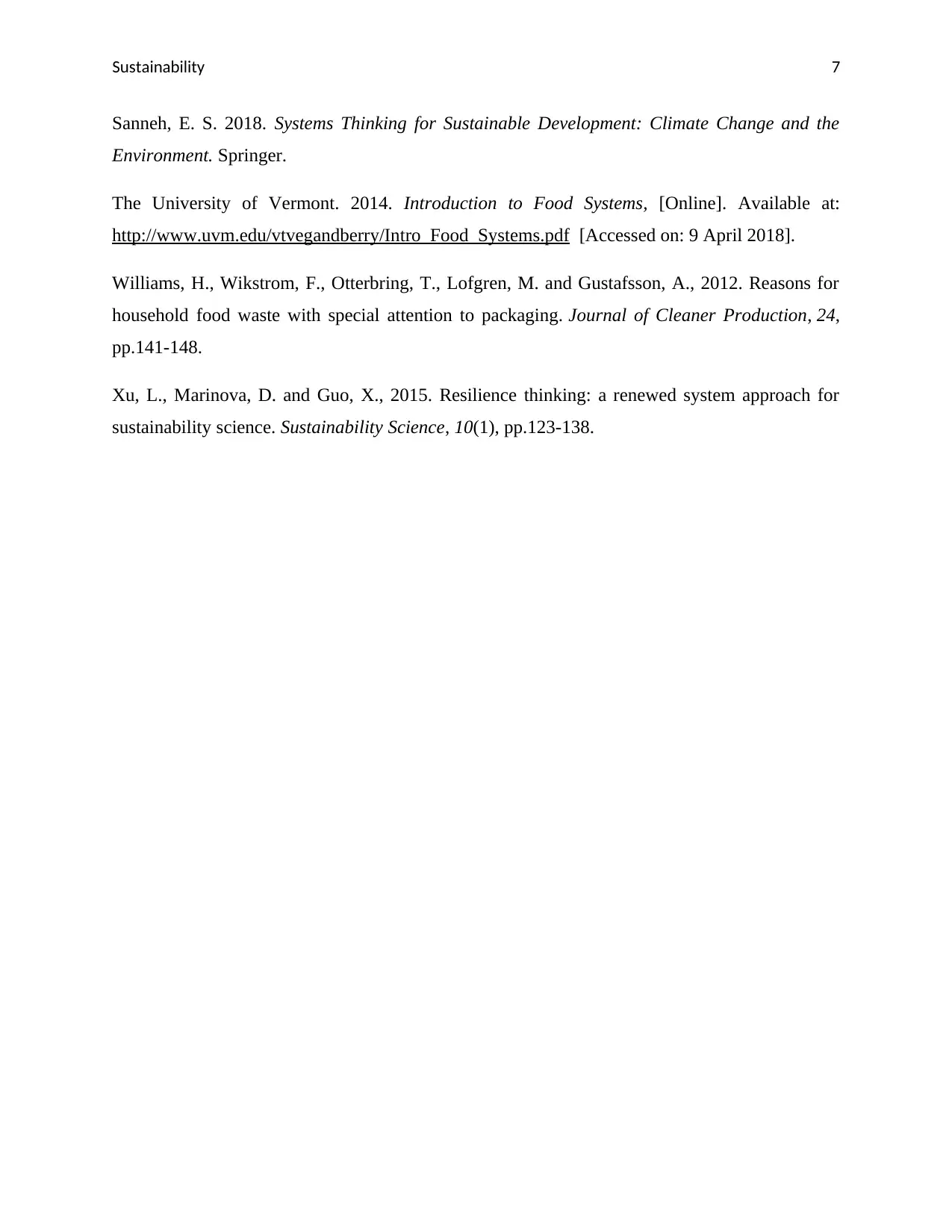
Sustainability 7
Sanneh, E. S. 2018. Systems Thinking for Sustainable Development: Climate Change and the
Environment. Springer.
The University of Vermont. 2014. Introduction to Food Systems, [Online]. Available at:
http://www.uvm.edu/vtvegandberry/Intro_Food_Systems.pdf [Accessed on: 9 April 2018].
Williams, H., Wikstrom, F., Otterbring, T., Lofgren, M. and Gustafsson, A., 2012. Reasons for
household food waste with special attention to packaging. Journal of Cleaner Production, 24,
pp.141-148.
Xu, L., Marinova, D. and Guo, X., 2015. Resilience thinking: a renewed system approach for
sustainability science. Sustainability Science, 10(1), pp.123-138.
Sanneh, E. S. 2018. Systems Thinking for Sustainable Development: Climate Change and the
Environment. Springer.
The University of Vermont. 2014. Introduction to Food Systems, [Online]. Available at:
http://www.uvm.edu/vtvegandberry/Intro_Food_Systems.pdf [Accessed on: 9 April 2018].
Williams, H., Wikstrom, F., Otterbring, T., Lofgren, M. and Gustafsson, A., 2012. Reasons for
household food waste with special attention to packaging. Journal of Cleaner Production, 24,
pp.141-148.
Xu, L., Marinova, D. and Guo, X., 2015. Resilience thinking: a renewed system approach for
sustainability science. Sustainability Science, 10(1), pp.123-138.
1 out of 8
Related Documents
Your All-in-One AI-Powered Toolkit for Academic Success.
+13062052269
info@desklib.com
Available 24*7 on WhatsApp / Email
![[object Object]](/_next/static/media/star-bottom.7253800d.svg)
Unlock your academic potential
Copyright © 2020–2025 A2Z Services. All Rights Reserved. Developed and managed by ZUCOL.




